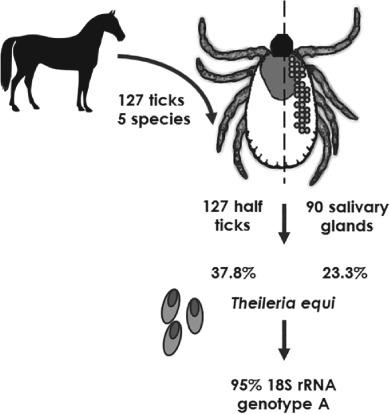当前位置:
X-MOL 学术
›
Med. Vet. Entomol.
›
论文详情
Our official English website, www.x-mol.net, welcomes your
feedback! (Note: you will need to create a separate account there.)
Potential tick vectors for Theileria equi in Israel.
Medical and Veterinary Entomology ( IF 1.6 ) Pub Date : 2020-02-27 , DOI: 10.1111/mve.12435 S Tirosh-Levy 1 , A Steinman 1 , A Einhorn 1 , D A Apanaskevich 2, 3 , K Y Mumcuoglu 4 , Y Gottlieb 1
Medical and Veterinary Entomology ( IF 1.6 ) Pub Date : 2020-02-27 , DOI: 10.1111/mve.12435 S Tirosh-Levy 1 , A Steinman 1 , A Einhorn 1 , D A Apanaskevich 2, 3 , K Y Mumcuoglu 4 , Y Gottlieb 1
Affiliation

|
Theileria equi Mehlhorn and Schein, 1998 (Piroplasmida: Babesiidae) is an important tick‐borne pathogen of horses that is highly endemic in many parts of the world, including Israel. The present study evaluated the potential roles of five hard tick species [Hyalomma excavatum Koch, 1844; Hyalomma marginatum Koch, 1844; Rhipicephalus turanicus Pomerantsev 1936; Rhipicephalus annulatus Say, 1821; Haemaphysalis parva (Neumann, 1897) (all: Ixodida: Ixodidae)], previously found to infest horses in Israel, in acting as vectors for piroplasmosis. For this, DNA was extracted from whole ticks and, when possible, from the salivary glands in each species (n = 10–59). Polymerase chain reaction amplification and sequencing of the 18S rRNA gene were used to detect T. equi in 48 of the 127 ticks (37.8%) and in 21 of the 90 extracted salivary glands (23.3%) in all five species. All but two sequences were classified as T. equi genotype A; the remaining two were classified as genotype D. The findings of this study point to Ha. parva and R. annulatus as potential novel vectors of T. equi , and suggest that parasite genotype selection occurs within the tick vector.
中文翻译:

以色列Theileria equi的潜在滴答矢量。
马氏泰勒虫(Theileria equi Mehlhorn and Schein),1998年(Piroplasmida:Babesiidae)是一种重要的由tick传播的马病原体,在世界许多地方都高度流行,包括以色列。本研究评估了五个硬壁虱物种的潜在作用[ Hyalomma excavatum Koch,1844; 边缘透明质酸Koch,1844年; Rhipicephalus turanicus Pomerantsev,1936年;Rhipicephalus annulatus说,1821年;Haemaphysalis parva(Neumann,1897)(所有:Ixodida:Ixodidae)],先前发现它在以色列感染马匹,并作为萤火虫病的媒介。为此,从整个tick中提取DNA,并在可能的情况下从每种物种的唾液腺中提取DNA(n = 10–59)。18S rRNA基因的聚合酶链反应扩增和测序被用于检测所有五个物种的127个s中的48个(37.8%)和90个提取唾液腺中的21个(23.3%)。除两个序列外,所有序列均归类为马氏毛虫基因型A。其余两个被归为基因型D。这项研究的发现指向Ha。parva和R. annulatus是T. equi的潜在新载体,并表明在the虫载体中发生了寄生虫基因型选择。
更新日期:2020-02-27
中文翻译:

以色列Theileria equi的潜在滴答矢量。
马氏泰勒虫(Theileria equi Mehlhorn and Schein),1998年(Piroplasmida:Babesiidae)是一种重要的由tick传播的马病原体,在世界许多地方都高度流行,包括以色列。本研究评估了五个硬壁虱物种的潜在作用[ Hyalomma excavatum Koch,1844; 边缘透明质酸Koch,1844年; Rhipicephalus turanicus Pomerantsev,1936年;Rhipicephalus annulatus说,1821年;Haemaphysalis parva(Neumann,1897)(所有:Ixodida:Ixodidae)],先前发现它在以色列感染马匹,并作为萤火虫病的媒介。为此,从整个tick中提取DNA,并在可能的情况下从每种物种的唾液腺中提取DNA(n = 10–59)。18S rRNA基因的聚合酶链反应扩增和测序被用于检测所有五个物种的127个s中的48个(37.8%)和90个提取唾液腺中的21个(23.3%)。除两个序列外,所有序列均归类为马氏毛虫基因型A。其余两个被归为基因型D。这项研究的发现指向Ha。parva和R. annulatus是T. equi的潜在新载体,并表明在the虫载体中发生了寄生虫基因型选择。











































 京公网安备 11010802027423号
京公网安备 11010802027423号